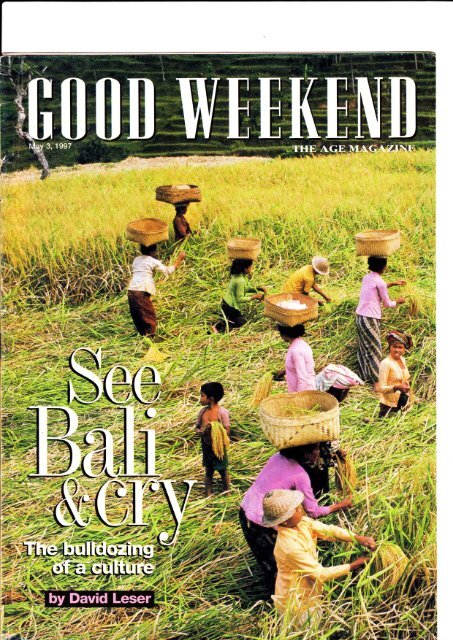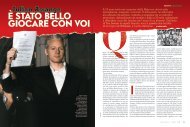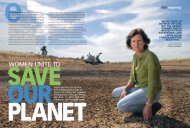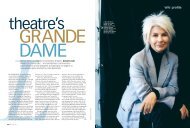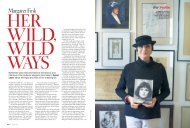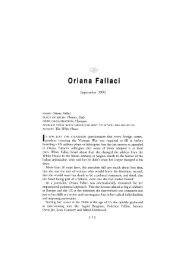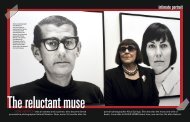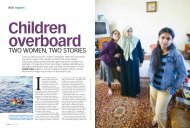''I i\
''I i\
''I i\
You also want an ePaper? Increase the reach of your titles
YUMPU automatically turns print PDFs into web optimized ePapers that Google loves.
\<br />
ffi<br />
'{<br />
\$<br />
!{<br />
I<br />
:i5tdi"i$<br />
t;<br />
hi<br />
';'rltsq<br />
ii[$tp; $,.,$rfi<br />
<strong>i\</strong> ;:r- i{',:<br />
ISu;it<br />
tisiSl<br />
'.*|}i,;<br />
:*.\\"<br />
it:'il'- 1<br />
lisl',i'Ti<br />
,i, 'i.,ii: i,'<br />
;: {\<br />
l\ti<br />
r''iT<br />
!t',ll,tW<br />
$ii <strong>''I</strong><br />
l'. i'<br />
lr't)<br />
r.,<br />
Wru i1.r\<br />
WSxu:<br />
f Si-.r --ll:-<br />
-lQta<br />
. *{8
It[ehru called Bali "the Morning of the World"<br />
Investors, including the Soeharto clan, are<br />
calling it a goldmine. fu development fever takes<br />
over, paradise is in danger of sinking under the<br />
weight of garbage, human waste and golf balls.<br />
Earewell<br />
his is a story about Bali Low,<br />
not Bali Ha'i. It is a story you<br />
will never get from tourist<br />
brochures, nor from your<br />
trusty travel agent. You certainly<br />
won't get it from the<br />
Indonesian Government. That's because<br />
it's about greed, politics and excrement.<br />
Literally. It's a tale that you might not<br />
like - if you're in the middle of your cornflakes<br />
or have just booked your annual<br />
holiday. But it's one that begs to be told,<br />
if not for the sake of your own health,<br />
then at least for Bali's.<br />
It's also one that should be told because<br />
of Bali's unique relationship with<br />
Australia. How many Australians have<br />
been touched by this tiny pearl in the<br />
Indonesian archipelago during the past<br />
30 years? Half a million? One million?<br />
More? How many suitcases have tumbled<br />
on to our airport carousels bearing its<br />
artefacts, how many Australian homes<br />
designed in its image, how many hearts<br />
stirred by its rich cultural processions of<br />
I exquisite young women and men?<br />
I for nearly 25 years, it has been the<br />
I most favoured overseas holiday destina-<br />
' tion for Australians. As of 1995, the figure<br />
stood at more than 8,000 a month, the<br />
: second highest source of tourists for the<br />
island after Japan. For most of us, Bali<br />
remains our most direct experience with<br />
;Indonesia, an exotic image to soothe any<br />
disquiet caused by, say, Jakarta's brutal<br />
subjugation of East Timor or its ruthless<br />
'muzzling of political dissent.<br />
You can, of course, still reach for the<br />
purple prose to describe the pink sunsets<br />
and the verdant rice terraces. You can still<br />
visit ancient temples, feast your eyes on<br />
people of grace and beauty, bathe in the<br />
pageantry of music, dance and drama that<br />
is Bali's unique cultural offering to the<br />
world. Let it be said, you can still have an<br />
incredible holiday in this place.<br />
It's only when you get out of your<br />
deckchair long enough to poke around on F<br />
E<br />
E<br />
6<br />
=o<br />
F<br />
o<br />
Id<br />
U<br />
I<br />
F
p<br />
a<br />
A<br />
S<br />
S<br />
p<br />
a<br />
p<br />
the spongy edges that you discover the<br />
"dark side of paradise" - Bali sinking into<br />
its own mire. Then you will see the sewage<br />
oozing out of the soil on the banks of the<br />
Sayan terraces outside Ubud, where the<br />
multi-million-dollar Four Seasons Hotel is<br />
being built at breakneck speed. You will<br />
see it in the wet season, excrement spilling<br />
from the septic tanks of three- and fourstar<br />
hotels into the streets of Kuta and<br />
Legian and then into the sea. You will see<br />
it in the rubbish dumps - legal and illegal -<br />
which sit like smoking ruins alongside<br />
motorways close to hotels and restaurants.<br />
You will see it in the reports that the<br />
Indonesian Government has not published<br />
about the state of Bali's beaches - bacteria<br />
levels so far above the World Health<br />
Organisation's recommended standards<br />
that you'd have to be crazy, or just plain<br />
ignorant, to take the plunge.<br />
The lact is, Bali is being dangerously<br />
overdeveloped and, with it, its environment<br />
and culture ransacked. Such is the hunger<br />
for the quick rupiah, the staggering lack of<br />
planning and basic urban infrastructure,<br />
and the level of cronyism and corruption<br />
within Indonesia, that the forces lined up<br />
against Bali look insurmountable. Hell,<br />
even Greg Norman has as good as given<br />
his imprimatur to the idea that rice sickles<br />
can be turned into golf clubs!<br />
HE IDEA of Bali as an island paradise<br />
first tantalised Westerners in<br />
the 1920s and '30s. It was unique<br />
among the world's exotic locations,<br />
a Hindu-animistic island in an Islamic sea,<br />
a museum of ancient Javanese culture. a<br />
flourishing temple-based society of kings,<br />
priests, scholars, artists and traders, an<br />
exotic fantasy where Europeans could find<br />
spiritual harmony and physical pleasure.<br />
The famous names who went there merely<br />
added to its lustre: artist Walter Spies,<br />
anthropologist Margaret Mead. actor<br />
Charlie Chaplin, actor and playwright Noel<br />
Coward. writer H.G. Wells.<br />
By the 1950s, non-Europeans had<br />
14<br />
succumbed, too. Nehru, India's first prime<br />
minister. visited the island and dubbed<br />
it "the Morning of the World". Former<br />
Indonesian president Sukarno, son of a<br />
Balinese mother, established a palace<br />
court there and in doing so elevated the<br />
island to a pre-eminent place in the<br />
Indonesian cultural firmament.<br />
With the succession to power of General<br />
Soeharto in 1.967, Bali became entrenched<br />
as the primary tourist destination in<br />
Indonesia. a place vital to the national<br />
economy. From the late 1960s it was backpackers<br />
looking for cheap losnens (Balinese<br />
guesthouses). surfies chasing ideal<br />
waves, hippies shopping for the best ganga.<br />
The 1970s and '80s<br />
saw this appeal<br />
broaden - everything<br />
from beer and<br />
skittles in Kuta to<br />
boutique holidays<br />
on rice terraces<br />
could be had for an<br />
affordable price.<br />
Then came the<br />
deregulation of Indonesia's financial system<br />
in 1988, and with it an unprecedented<br />
investment boom. Licences to start private<br />
banks became freely available and controls<br />
over interest rates removed. Massive<br />
amounts of credit were on offer from<br />
domestic as well as foreign banks and in<br />
Bali this translated into a huge injection<br />
of money into the tourist industry.<br />
Suddenly the island was a rich man's<br />
honey pot. particularly for a growing new<br />
Javanese middle class. According to<br />
Dr Carol Warren from the Asian Studies<br />
Program at Western Australia's Murdoch<br />
University. investment in major tourist<br />
projects on the island soared from<br />
$US17 million in 1987 to $US170 million<br />
in 1988. Between 1988 and 1995, that figure<br />
rose steadily to $US295 million.<br />
Many of these tourist projects were residential<br />
resorts offering Jakarta's new rich,<br />
and also a growing number of holidaymakers<br />
from Asia, a home away from home.<br />
This had some positive benefits for<br />
many Balinese. Thirty years ago Balinese<br />
children were dying from malnutrition.<br />
Now families could afford to build new<br />
homes, buy motorcycles, send their children<br />
to schools. The tourist industry<br />
spawned thousands of new businesses -<br />
handicrafts, fashion, furniture. art, cuisine.<br />
But according to Carol Warren, who<br />
has studied the impact of tourism on<br />
Bali's environment and culture, this huge<br />
injection of money also had a harmful<br />
effect on Balinese life. "Despite a continuous<br />
flow of rhetoric espousing earlier<br />
commitments to'cultural tourism',"<br />
Warren said, "development policy has<br />
Gods and golf: one of Balinese<br />
Hinduism's most important temples<br />
is within a few hundred metres of the<br />
new Bali Ninrvana Resort (below).<br />
become almost entirelv geared toward the<br />
gross maximisation of tourist numbers<br />
and the income thel, might generate. This<br />
in turn has created acute environmental<br />
and social problems."<br />
Bali's development fever is staggering.<br />
Everv dav the embryo of yet another hotel<br />
or condonrinium takes form, thus eliminating<br />
another vestige of traditional Bali. In<br />
man\'\\'avs it is a microcosm of the struggle<br />
being waged across Indonesia: how to satisfy<br />
the interests of economic growth and<br />
still preserve the stability and unity of a<br />
diverse people, many of whom are wedded<br />
to time-honoured ways of life. "If there is<br />
no tourism, we can't develop in Bali,"<br />
I Made Samba, head of the Tabanan<br />
regency's planning board, told the Far<br />
Eastern Economic Review when confronted<br />
with opposition to one of Bali's biggest<br />
tourist resorts at Tanah Lot in 1994.<br />
"We rebel against Bali becoming the<br />
pleasure park of the world," retorted Ibu<br />
GOODWEEKEND MAY3. I997
Gedong Bagoes Oka, who led the worshippers<br />
in protest against this project and was<br />
prepared to voice her concerns. (Such is the<br />
culture of fear that pervades not just Bali<br />
but Indonesia as a whole that it is often<br />
difficult to get people to speak their mind.)<br />
Conspicuous among the development<br />
projects are a number of giant luxury<br />
resorts connected to President Soeharto<br />
and his children. "Bali has become a colony<br />
of Jakarta's, a playground for the Javanese<br />
elite, especially the Soeharto family," says<br />
Dr George Aditiondro, an Indonesian academic<br />
and dissident now living in Australia.<br />
"The entire tourist industry on that island is<br />
monopolised by one clan, which is the<br />
President's family. It is terrible because it is<br />
destroying the environment. it is destroying<br />
the local democracy which is bound up in<br />
Ihe subak [irrigation farming] system and it<br />
is not contributing much to the economy."<br />
Within Indonesia the extent of the<br />
Soeharto children's empire is largely a<br />
matter of public record for the very reason<br />
that family members see it as testament to<br />
their business acumen. They have major<br />
shares in commercial ventures ranging<br />
from sophisticated satellite technology to<br />
bottled water and cigarettes, from property<br />
to petrochemicals, broadcasting to banking,<br />
taxis to road tolls and, as recent reports<br />
have indicated, to dubious gold deposits<br />
in Borneo's East Kalimantan province.<br />
According to Professor Richard Robison,<br />
GOOD WEEKEND MAY 3. 1997<br />
director of the Asia Research Centre at<br />
Murdoch University, this "acumen" stems<br />
largely from their position in the family and<br />
the fact that rarely, if ever, do they have to<br />
dip into their own pockets. "The Soeharto<br />
children get most of their money from the<br />
state banks and don't pay it back," he says.<br />
George Aditjondro has documented the<br />
extent of the Soeharto family's holdings in<br />
Bali. Sigit Harjojudanto. for example, is<br />
President Soeharto's eldest son and owns,<br />
among other properties, shares in the Bali<br />
Cliff Resort Hotel, where former prime<br />
minister Paul Keating once met Soeharto.<br />
The hotel is built in the Nusa Dua area,<br />
on the Bukit peninsula, 75 metres above<br />
the sea with an<br />
elevator carved<br />
into the cliffs.<br />
Just to the east<br />
of the Bali Cliff is<br />
the Nikko Bali<br />
Hotel, also partowned<br />
by Sigit.<br />
Like the Bali Cliff.<br />
the Nikko is built<br />
on a cliff face.<br />
The original structure,<br />
designed by<br />
Indonesian engineers<br />
and financed<br />
All in the family:<br />
President<br />
Soeharto (left)<br />
and three of his<br />
children (above,<br />
from left) Tutut,<br />
Sigit Harjojudanto<br />
(with wife Elsye)<br />
and Bambang.<br />
through the now banned<br />
state lottery (SBSD),<br />
was not planned for<br />
earthquake conditions<br />
which are prevalent<br />
throughout the island.<br />
According to Jill<br />
Morrison, the Australian<br />
site representative<br />
for the hotel's interior<br />
fit-out, shortcomings in<br />
the original design were<br />
remedied by Perth-based engineers Ove<br />
Arup and Partners, although geotechnical<br />
advice given to the lndonesian owners<br />
still warned that in the event of a major<br />
earthquake the cliff face was susceptible<br />
to collapse.<br />
Morrison said that during the construction<br />
phase, 14 people had died on site.<br />
(The unofficial figure was 35.) "Some were<br />
crushed when material fell from a crane<br />
because it wasn't properly secured," she<br />
says. "One was electrocuted; a couple fell<br />
from the tower of the 14th and 15th<br />
storeys. There were no safety rails and no<br />
protective clothing for the workers. People<br />
worked in thongs, and hard hats were only<br />
issued to the labourers halfway through<br />
the project because they demanded it, not<br />
because the Indonesian builders felt it was<br />
appropriate. I think the labourers may<br />
have paid for the hard hats themselves."<br />
So slipshod are some building practices<br />
that the foundations for at least one hotel<br />
in Legian were laid on a bed of waste<br />
matter. As recounted to GooD WeEreNl<br />
by one environmental source, the engineer<br />
was instructed to lay the foundations<br />
to a depth of 12 metres. At 8 metres he<br />
discovered a sewerage aqueduct and<br />
insisted to the site manager that the<br />
sewage be pumped out and the aqueduct<br />
be filled with cement before construclion<br />
resumed. He was sacked on the spot.<br />
Structural and worker safety is only one<br />
of the many hidden costs of rampant<br />
growth Indonesian-style. The disposal of<br />
waste is another. Bali has no integrated<br />
system for dealing with garbage or human<br />
waste. Some of the more luxurious hotels<br />
are now treating their own sewage but the<br />
majority of hotels and losmens still rely<br />
on septic tanks.<br />
"I can show you hotels in Kuta and<br />
Legian where the septic tanks have overloaded<br />
and they've had to close the footpaths<br />
to the beach because of the<br />
excrement," said one Indonesian-based<br />
Australian engineer who spoke to Gooo<br />
WeereNo on the condition of anonymity.<br />
"The control of human, plastic and solid<br />
waste is the big issue on Bali and nobody<br />
is listening," says Sean Foley, an Australian<br />
living in Bali and working as an<br />
environmental consultant to a number of<br />
United Nations projects. "This island will<br />
eventually disappear under a sea of crap if<br />
nothing is done soon."<br />
Documents from Udayana University<br />
in Bali's capital Denpasar obtained by<br />
Gooo WrexeNo reveal levels of faecal<br />
coliforms in the waters around Bali way<br />
above World Health Organisation recommended<br />
standards of zero.<br />
So polluted are the waters that environmental<br />
experts don't discount the possibility<br />
of a large-scale cholera outbreak. "It's<br />
not a very popular notion," says Rio Helmi,<br />
vice-chairman of the Wisnu Foundation.<br />
Bali's only environmental organisation,<br />
"but I think the possibility exists of a very<br />
large-scale cholera breakout. We've had<br />
smaller incidents where people have been<br />
infected, but it's never been widespread.<br />
Every day the possibility gets bigger."<br />
In early 1995, newspapers reported that<br />
61 Japanese tourists contracted cholera<br />
after returning from Bali. Japanese health<br />
authorities issued health warnings<br />
which were immediately discounted by<br />
15<br />
tr<br />
U Fd
p<br />
a<br />
A<br />
SI<br />
S<br />
p<br />
a<br />
p<br />
Indonesian authorities. "There was a huge<br />
campaign mounted within Indonesia<br />
towards Japan discounting it, saying it<br />
was all hysteria," said one local source<br />
who insisted that his identity be concealed.<br />
"Instead of taking that as a warning bell<br />
and saying, 'Now we really have to get<br />
into action and do something about the<br />
situation', it was all covered up. It was like<br />
the problem didn't exist."<br />
Melody Kemp, an Australian environmental<br />
health consultant based on the<br />
island. advises against swimming in most<br />
tourist areas. "Anyone who goes and<br />
swims in the ocean here should be concerned<br />
for their health," she says.<br />
"Doctors are increasingly seeing people<br />
suffering from ear, nose and eye infections<br />
in addition to the usual Bali belly."<br />
Kemp gained some notoriety for herself<br />
last year when she wrote to The Jakarta<br />
Posr newspaper decrying plans for a new<br />
(Sheraton) Four Seasons hotel on the<br />
banks of the Ayung River near the cultural<br />
centre of Ubud. Designed by former<br />
Singapore Prime Minister Lee Kuan<br />
Yew's nephew and due for completion by<br />
July, the hotel is an enormous edifice set<br />
in what was once a traditional rural landscape<br />
of rice paddies and coconut trees.<br />
Although Four Seasons management<br />
insist the hotel is not being built inside an<br />
environmentally protected area, a study<br />
of local maps obtained by Gooo Wpex-<br />
END suggests otherwise.<br />
Among the hotel's many features is a<br />
swimming pool grafted on to the river bank<br />
16<br />
close to holy springs and to where local<br />
villagers have been bathing for centuries.<br />
It is also where the ceremonial ash of the<br />
deceased has long been deposited. Royal<br />
Rowe, general manager of Four Seasons,<br />
said the reason for the pool's location<br />
there was simple: "Aesthetics". He<br />
added that the Balinese were more than<br />
welcome to continue bathing there if<br />
they wanted.<br />
While defending his own project, Rowe<br />
made it clear he believed the pace of<br />
change in Bali was too rapid. "With development<br />
here, frankly I don't know where<br />
they're going to get the water from." he<br />
said. Rowe confirmed that President<br />
Soeharto's third son, Tommy, owned a<br />
share of the Four Seasons hotel in Sayan<br />
but doubted it was as high as 30 per cent.<br />
as widely rumoured. "I would imagine<br />
it's probably less than 10 per cent, maybe<br />
even less than five," he said.<br />
Aside from owning a sizeable share of<br />
the other Four Seasons Hotel at Jimbaran<br />
Bay, Tommy Soeharto, believed to be the<br />
president's favourite son, owns, together<br />
with the army, PT Sempati Air, the airline<br />
that flies regularly between Jakarta,<br />
Denpasar and Perth; shares in PT Tirta<br />
Artha Buana. a company that provides<br />
drinking water to three key tourist areas<br />
in Bali; shares in PT Ayung River Rafting,<br />
a company that sells rafting rides down<br />
the Ayung River (close to where the Four<br />
Seasons hotel is situated); and perhaps<br />
most significantly, shares in PT Bali Benoa<br />
Marine (BBM), the company converting<br />
Benoa Bay into a major tourist resort.<br />
Tommy's Benoa Bay project will form<br />
part of what seems to be Indonesia's<br />
answer to the Gold Coast, a string of gigantic<br />
developments along the southern coast<br />
of the island designed to attract mass<br />
tourism, especially from Jakarta's burgeoning<br />
elite anxious to escape the capital's<br />
worsening traffic snarls and pollution.<br />
These expansions are a dramatic departure<br />
from the recommendations of a 1971<br />
Master Plan for tourism drawn up by<br />
French consultants. This plan called for<br />
three established tourist zones - in the<br />
Nusa Dua. Sanur and Kuta areas - to contain<br />
the impact of mass tourism. The<br />
philosophy behind this plan was that Nusa<br />
Dua, in particular, was going to absorb<br />
the high-class hotels, with the Kuta and<br />
Sanur areas offering smaller-scale<br />
accommodation more suitable to their<br />
surroundings. However, such was the<br />
appetite for tourism investment by provincial<br />
and regional government authorities<br />
left out of the original plan that by 1988<br />
the number of zones had increased to 15.<br />
Five years later. by decree of the Governor<br />
of Bali, this number had increased to<br />
21, thereby opening one-quarter of the<br />
island and an estimated one-in-five Balinese<br />
villages to commercial exploitation.<br />
The Governor of Bali, Ida Bagus Oka,<br />
declined to respond to a number of questions<br />
faxed to him by Gooo WeereNo.<br />
including reasons for this dramatic departure<br />
from the original tourist plan.<br />
Speaking to GooD WeexeNo through<br />
an interpreter, Nyoman Gelebet. a former<br />
consultant on the 1971 Master Plan, said<br />
Bali now was being "smashed" by "eight<br />
monster projects". One of them is Tommy<br />
Soeharto's Benoa Harbour where 20 million<br />
cubic metres of sand fill are being<br />
dredged to create a "dreamworld" resort<br />
that will include a giant marina, five golf<br />
courses. luxury villas, condominiums,<br />
shopping centres and hotels.<br />
The dredging serves another purpose as<br />
well - to increase fourfold the size of<br />
nearby Pulau Serangan (Turtle Island),<br />
considered possibly the most controversial<br />
of all Bali's grand schemes.<br />
The project has been defended on the<br />
grounds that it will save the island from<br />
'sinking' due to its increasing population,<br />
as well as arrest beach erosion from the<br />
nearby brackish water shrimp ponds.<br />
Opponents argue that apart from violating<br />
Balinese religious sensibilities - the project<br />
is located next to Bali's second most important<br />
temple - it is an environmental disaster<br />
waiting to happen. It rvill alter tidal<br />
patterns as well as destroy fishing<br />
grounds, mangrove swamps, seagrass<br />
and the coral reef itself. There<br />
are also plans to blorv up a mountain<br />
near to a small fishing village<br />
on the east coast and extract rocks<br />
in order to help build a sea wall<br />
around the expanded island.<br />
"For me. Serangan encapsulates<br />
everything that is going up the wall about<br />
Bali," Melody Kemp says. "There is so<br />
much greed that it has turned to decadence<br />
and in the process they are making<br />
stupid decisions.<br />
"One, Serangan is on the flight path of<br />
the airport so there will be a steady flow of<br />
low-level aircraft noise. And two, it's at the<br />
confluence of five major rivers, all of which<br />
are bearing industrial and human waste.<br />
Anyone going in the water there is going<br />
to get incredibly ill - if not from diarrhoeal<br />
disease then from the heavy metals and<br />
high levels of toxic dye from the Batik<br />
industries found along these rivers."<br />
The initial environmental impact study<br />
for Serangan was prepared by the Perthbased<br />
environmental consultancy firm<br />
LeProvost, Dames and Moore, which<br />
questioned the concept on numerous ecological<br />
grounds. After issuing its findings,<br />
the firm was dumped in favour of a local<br />
group headed by Professor R. Mardani,<br />
the former head of Denpasar University's<br />
GOOD WEEKEND MAY 3. 1997
environment studies centre who was later<br />
placed in charge of tourism. Professor<br />
Mardani, according to well-placed<br />
sources, was far from enthusiastic about<br />
the project but was in no position to<br />
oppose its continuation.<br />
Rare are the times that the Balinese<br />
engage in active protest. Rare because they<br />
prefer to avoid open conflict and rare because<br />
to protest is to invite retribution from<br />
the Government. This is why the demonstrations<br />
in early 1994 remain a watershed<br />
in contemporary Balinese history. Angered<br />
by a giant resort at Tanah Lot, site of one<br />
of the most important - and easily most<br />
photographed - shrines in Balinese<br />
Hinduism, thousands of people took to<br />
the streets to voice their opposition. The<br />
demonstrations were brutally suppressed.<br />
The Tanah Lot project, known as the<br />
Bali Nirwana Resort, is controlled by the<br />
Bakrie Group, a conglomerate with longstanding<br />
business connections to the<br />
Soeharto family. It was the first of the<br />
mega-resorts approved for the island in<br />
1991 and is due to open this year, its<br />
many features including a 401-room,<br />
five-star hotel. 450 residential units and<br />
an 1.8-hole international golf course<br />
designed by Greg Norman.<br />
"Tanah Lot distinguishes itself because<br />
it is a gross transgression of a very sacred<br />
site," says Carol Warren. (To tee off from<br />
the 12th hole is to come within 150 metres<br />
of the temple.) Bulldozers began levelling<br />
the land around Tanah Lot in the early<br />
'90s before all land-holders had agreed to<br />
sell, before the required building permits<br />
were issued or before the environmental<br />
impact assessment process had been completed.<br />
Many farmers were forced to sell,<br />
while many others who did so willingly<br />
decided later they had been duped.<br />
"We were told that our land was going<br />
to be taken for government projects," said<br />
one farmer who spoke to Gooo WpErpNp<br />
through an interpreter. "It seemed to us<br />
that the Government needed our land. We<br />
didn't realise until after we got the papers,<br />
until after we sold the land, that it said<br />
Bali Nirwana Resort at the top."<br />
In the few years since the land was taken,<br />
prices have soared from about $1,600 per<br />
L00 square metres to $16,000 last year.<br />
By next year, one landlord is expecting to<br />
be able to sell his plot for about $40,000.<br />
LOGAN<br />
O{.JT]D O OR. ]H]ER.]I'I[AG]E "<br />
Golf now poses one of the greatest<br />
threats to Bali's ecosystem. At Tanah Lot<br />
two-thirds of the land resumed for the<br />
project is taken up by the Normandesigned<br />
golf course. Given that a golf<br />
course can consume as much as 400,000<br />
litres of water a day, Warren claims this<br />
to be an unacceptable concentration of a<br />
precious resource. Plans for 26 more golf<br />
courses on the island make this a matter<br />
of growing urgency.<br />
"The golf course is a maniac consumer<br />
of water and purveyor of environmental<br />
disaster," Professor Manuaba, one of Bali's<br />
most respected environmental commentators,<br />
told the local Bali Post in 1993.<br />
According to Warren, the island is now losing<br />
1,000 ha of rice paddy each year. "This<br />
means one of the most fertile and productive<br />
agricultural regions in the world will<br />
soon be facing rice shortages." It will also<br />
mean further contamination of the water<br />
table because of the hearry use of fertilisers<br />
and chemicals, as well as the destruction<br />
of local customs associated withthe subak.<br />
George Aditjondro has urged that<br />
plans for further golf courses on the<br />
island be suspended. He has also called D<br />
Available exclusively from Outdoor Heritage stores: MELBOURNE: Chadstone Shopping CentrE Melbourne Central,<br />
Doncaster Westffeld Shopping Centre. SYDNEY Chatswood Chase, Argyle Department Store The Rocks OR CALL: 1-800-641 168 oHrs<br />
!*<br />
c$<br />
I-:<br />
i;
for Greg Norman to pull out of the Bali<br />
Nirwana Resort and donate his estimated<br />
fee of $1 million to the farmers and local<br />
religious authorities.<br />
"Politically and financially it would be a<br />
very important gesture because so many<br />
farmers have lost their land," he said.<br />
Norman declined to respond to a number<br />
of questions faxed to his corporate representatives<br />
by Gooo WprreNo.<br />
N A FULL moon evening in<br />
September last year, thousands of<br />
delegates from around the world<br />
attended a World Tourist Organisation<br />
conference on Bali's Sanur beach.<br />
Made Wijaya, an Australian-born landscape<br />
architect who has lived on the<br />
island for the past 24 years, doubts that<br />
any other place in the world could have<br />
turned on such a show. Wijaya has<br />
designed gardens for more than 50 hotels<br />
in Bali and is regarded as something of a<br />
local cultural watchdog. He was sceptical<br />
about such a conference being held.<br />
"I was sort of against it," he says, "the<br />
idea of having [ceremonial] tooth filings to<br />
order on the footpath. But I went there<br />
and, true to form, the Balinese pulled out<br />
all stops. There were 100 jukungs, those<br />
outriggers with the red sails; and tooth<br />
filing and people pounding rice and people<br />
being married and monsters and the whole<br />
unbelievable ceremonial Balinese year<br />
compacted into 20 metres of footpath, like<br />
the Royal Easter Show except all cultural.<br />
"And these delegates from countries<br />
which really have little culture and little<br />
to offer in terms of cultural tourism were<br />
just flabbergasted." Wijaya believes the<br />
Balinese culture is infinitely flexible and<br />
resilient but that it now needs tourism to<br />
survive. "It has survived colonisation,<br />
Islamicisation, Christianisation ... [but]<br />
without the tourist dollar, this wonderfully<br />
dynamic culture really couldn't survive<br />
into the 21st century," he says.<br />
Ibu Mas, an aristocratic Balinese whose<br />
small village guesthouse near Ubud has<br />
been recognised internationally for its<br />
holistic approach to tourism, is one of<br />
many Balinese who disagrees with this<br />
view. She believes the island is threatened<br />
as never before. The pace of change is<br />
unprecedented. Land speculation is so<br />
rampant that parents and children now<br />
fight over what to do with their herjtage.<br />
Do they sell their small holdings for fourist<br />
purposes or retain it for agriculture? "The<br />
balance has been tipped," she says. "It is<br />
creating a lot of conflict ... because the<br />
GOOD WEEKEND MAY 3, 1997<br />
culture of jealousy is becoming stronger<br />
and working its way through families."<br />
In 1993, in the district of Gianyar, the<br />
regional head ordered the removal of all<br />
roadside trees, believing tourists preferred<br />
treeless streets. Now there is no shade. In<br />
Kuta a beautiful river that until a few years<br />
ago wended its way through the town has<br />
been filled. Around Denpasar enormous<br />
areas of rice fields have vanished. At<br />
Candidasa the beach has disappeared<br />
following the mining and bombing of coral<br />
reefs and the construction of hotels too<br />
close to the high watermark. At Gilimanuk,<br />
on the west coast, plans are under way for a<br />
bridge connecting the island with Java. The<br />
tide looks unstoppable.<br />
' And everywhere, the fingerprints of the<br />
Soeharto family or their friends. According<br />
to well-placed expatriate sources, Siti<br />
Hardiyanti Rukmana, the President's<br />
eldest daughter, otherwise known as<br />
Tutut, and her younger sister Siti Hediati<br />
Prabowo (Titiek) have recently bought up<br />
national forest and a stretch of the west<br />
coast for what will soon be another resort.<br />
Tutut is now widely tipped as the next<br />
vice-president of Iridonesia. Their brother<br />
Tommy is believed to have just been<br />
granted the izin lokasi (permit to develop<br />
land) for the Buleleng region. This will<br />
give him control over most of West Bali,<br />
including much of the national park, up to<br />
Singaraja. In Payangan, near Ubud, hundreds<br />
of hectares of rice paddy have been<br />
acquired by a conglomerate with close ties<br />
to Bambang, Soeharto's second son. The<br />
local joke is that farmers will soon be<br />
wearing hard hats while they work so they<br />
don't get injured by stray golf balls.<br />
At Pecatu, in the south, farmers have<br />
risen up in protest against Tommy<br />
Soeharto's plans for a tourist city that will<br />
eclipse anything yet conceived for the<br />
island. Their only hope now is that their<br />
protests are being backed by the opposition<br />
Indonesian Democratic Party (PDI)<br />
and the Legal Aid Foundation.<br />
As Indonesia heads towards election day<br />
on May 29 - an almost foregone victory for<br />
President Soeharto and the ruling Golkar<br />
party - social unrest throughout the archipelago<br />
continues to mount. Riots in Jakarta<br />
last year, riots in Lombok this year, continuing<br />
resistance in East Timor and Irian<br />
Jaya every year, growing ethnic unrest in<br />
West Kalimantan and an insurrection that<br />
shows no sign of abating in north Sumatra.<br />
By comparison, Bali looks calm, especially<br />
poolside from the deckchair. But so did<br />
Mount Agung in 1963 before it erupted. I<br />
AT<br />
LAGUNA QUAYS<br />
RESORT<br />
WE,LL GIVE YOU<br />
$3oo<br />
TO SPEND AS YOU<br />
CHOOSE.<br />
Now when you stay at Laguna<br />
Quays Resort, in the heart of the<br />
Whitsundays, we'll give you $300 in<br />
Choice Cheques to spend on a wide<br />
variety ofpleasures. From cruises and<br />
golf to shopping and dining .' the<br />
choice is yours.<br />
At Laguna Quays you can choose<br />
to play a round on the 18 hole<br />
championship golf course, cruise to<br />
the Great Barrier Reef, play a game<br />
of tennis, cycle, sample a variety of<br />
watersports or you may prefer to<br />
just relax and let us take care of<br />
everything (including the kids).<br />
And with the $300 in Choice<br />
Cheques you'll receive upon arrival,<br />
your choices are endless.<br />
For further information call<br />
Toll free on 1-300 353 300 or Free<br />
Call I 800 812 626 or see your local<br />
Travel Agent.<br />
LAGUTIA QUAYII<br />
A WHITSUNOAY FESOFA<br />
-RESOtl-<br />
PA(rcYAL HM6 f, R&M. A MEMBER OF ffI SPHC CrcUP<br />
q


